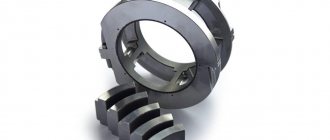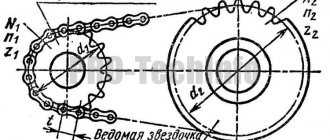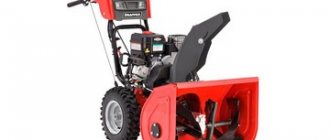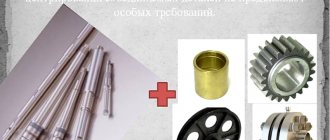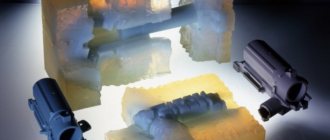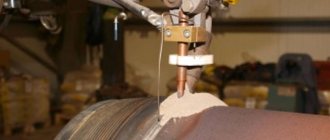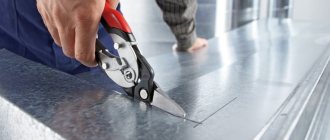material provided by SIDOROV Alexander Vladimirovich
Bearing
- a product that is part of a support or stop that supports a shaft, axle or other movable structure with a given rigidity. Fixes the position in space, ensures rotation, rolling or linear movement (for linear bearings) with the least resistance, perceives and transmits the load from the moving unit to other parts of the structure. [, ]
Forces loading the bearing
, are divided into:
- radial, acting in the direction perpendicular to the bearing axis;
- axial, acting in a direction parallel to the bearing axis.
A support with a thrust bearing is called a thrust bearing
.
Sleeve bearing
- a support or guide of a mechanism or machine in which friction occurs when mating surfaces slide.
A radial sliding bearing is a housing with a cylindrical hole into which a working element is inserted - a liner, or a bushing made of antifriction material and a lubricating device. There is a gap between the shaft and the bearing sleeve hole filled with lubricant, which allows the shaft to rotate freely.
Depending on the design, peripheral speed of the axle, and operating conditions, sliding friction can be dry, boundary, liquid, and gas-dynamic. However, even bearings with fluid friction go through a phase with boundary friction during startup.
Lubrication
is one of the main conditions for reliable operation of the bearing and
ensures
:
- low friction;
- separation of moving parts;
- heat sink;
- protection from harmful environmental influences.
Lubrication happens
:
- liquid (mineral and synthetic oils, water for non-metallic bearings);
- plastic (based on lithium soap and calcium sulfonate, etc.);
- solid (graphite, molybdenum disulfide, etc.);
- gaseous (various inert gases, nitrogen, etc.).
The best performance properties are demonstrated by porous self-lubricating bearings made by powder metallurgy. During operation, a porous self-lubricating bearing, impregnated with oil, heats up and releases lubricant from the pores onto the working sliding surface, and at rest it cools and absorbs the lubricant back into the pores.
Antifriction bearing materials are made from hard alloys (tungsten carbide or chromium carbide using powder metallurgy or high-speed flame spraying), babbit and bronze, polymer materials, ceramics, hard wood (iron wood).
Sleeve bearings separate
:
- depending on the shape of the bearing hole: single- or multi-surface;
- with displacement of surfaces (in the direction of rotation) or without (to maintain the possibility of reverse rotation);
- with or without center offset (for final installation of shafts after installation);
- radial;
- one-piece (sleeve);
- with one valve;
- unregulated;
The classes of plain bearings are shown in Table 1.
Table 1 – Classes of plain bearings
| Group | Class | Lubrication method | Type of friction | Friction coefficient | Purpose | Application area |
| I (imperfect lubrication) | 1 | small quantity, inconsistent supply | boundary | 0,1-0,3 | low sliding speeds and low specific pressures | support rollers of conveyors, running wheels of overhead cranes |
| 2 | usually continuous | semi-liquid | 0,02-0,10 | short-term mode with constant or variable direction of shaft rotation, low speeds and high specific loads | linear and forming machines, press-forging equipment, rolling mills, lifting machines | |
| 3 | oil bath or rings | 0,001-0,020 | forces that vary little in magnitude and direction, large and medium loads | wagon axle boxes, heavy machine tools, powerful electrical machines, heavy gearboxes, textile machines | ||
| under pressure | variable load | gas engines, low-speed and marine engines | ||||
| II | 4 | rings, combined or pressurized | liquid | 0,0005-0,0050 | low peripheral speeds of shafts, especially difficult working conditions with loads varying in magnitude and direction | medium and low power electrical machines, light and medium gearboxes, centrifugal pumps and compressors, rolling mills |
| 5 | under pressure | 0,005-0,050 | lightly loaded supports with high sliding speeds | steam boilers, water turbines, gas turbines, axial fans, turbochargers |
Advantages of plain bearings
:
- reliability in high-speed drives;
- ability to withstand significant shock and vibration loads;
- relatively small radial dimensions;
- allow the installation of split bearings on crankshaft journals and do not require dismantling other parts during repairs;
- simple design in low-speed machines;
- ability to work in water;
- allow adjustment of the gap and ensure precise installation of the geometric axis of the shaft;
- economical for large shaft diameters.
Disadvantages of plain bearings
:
- during operation they require constant supervision of lubrication;
- relatively large axial dimensions;
- large friction losses during start-up and with imperfect lubrication;
- high consumption of lubricant;
- high requirements for temperature and lubricant purity;
- reduced efficiency;
- uneven wear of the bearing and axle;
- use of more expensive materials;
- increased noise.
Rolling bearings
consist of two rings, rolling elements (of various shapes) and a cage (some types of bearings may be without a cage), separating the rolling elements from each other, holding them at an equal distance and directing their movement. Along the outer surface of the inner ring and the inner surface of the outer ring (on the end surfaces of the rings of thrust bearings), grooves are made - raceways, along which the rolling elements roll when the bearing operates.
In some machine components, in order to reduce dimensions, as well as increase accuracy and rigidity, so-called combined supports are used: the raceways are made directly on the shaft or on the surface of the housing part.
There are rolling bearings made without a cage, which have a large number of rolling elements and a large load capacity. However, the maximum rotational speeds of full complement bearings are significantly lower due to increased torques of rotational resistance.
In rolling bearings, rolling friction occurs predominantly (there are only small losses due to sliding friction between the cage and the rolling elements), therefore, compared to sliding bearings, energy losses due to friction are reduced and wear is reduced. Closed rolling bearings (with protective covers) require virtually no maintenance (lubricant replacement), while open ones are sensitive to the ingress of foreign bodies, which can lead to rapid destruction of the bearing.
Classification of rolling bearings
carried out on the basis of the following characteristics:
- by type of rolling elements: ball;
- roller (needle-shaped if the rollers are thin and long);
- radial (load along the shaft axis is not allowed);
- single row;
- self-aligning;
Examples of bearings of various types are presented in Figure 1 [].
Radial roller bearing | Thrust ball bearing |
Thrust roller bearing | Angular contact ball bearing |
Angular contact ball bearing with four-point contact | Angular contact roller bearing (tapered) |
Self-aligning double row deep groove ball bearing | Self-aligning radial roller bearing |
Self-aligning angular contact roller bearing | Self-aligning double row radial roller bearing with barrel rollers (spherical) |
| Needle bearing roller cage | Linear rail bearing |
Linear telescopic bearing | Ball screw drive |
Figure 1 – Types of bearings
What is a part?
This mechanism reduces friction when the axle rotates in the eye. Similar devices have been used by mankind since Neolithic times, when people first used fat to lubricate axles. An example of this is the potter's wheel. During construction and irrigation, the Egyptians widely used all types of blocks and lubricated all rotating parts with oil and water. Later they began to use tar, graphite, and wax to lubricate wheel axles.
Modern parts are completely different high-tech products.
In the article you can find general information about the sliding bearing and see a photo of what the mechanism looks like.
The classic device consists of two bushings tightly fitted to each other with a high degree of surface treatment. To slide between the planes, a lubricant is added, or one of the elements is made of a slippery substance, for example, graphite or fluoroplastic.
International system
Thus, in Russia, enterprises manufacturing bearings must adhere to GOST without fail. It is not at all difficult to determine what a product produced in our country is by looking at its labeling. With imported devices of this type, unfortunately, everything is far from so simple.
Abroad, the classification of bearings is the same as ours, but, unfortunately, there is no generally accepted clear designation system there. Foreign manufacturers label their products as they please.
Additional designations on bearings made, for example, in China, can be applied both before and after the main block. The basic information itself, as in the Russian system, is usually presented in the form of several numbers (3-5). Most often in the marking of imported bearings:
- the first character indicates the type of product;
- the next two digits represent the ISO size series;
- the last two digits indicate the bearing size code.
As in the Russian system, in the Chinese the last two digits, if any, should be multiplied by 5. In this way, the internal diameter of the bearing can be determined in millimeters.
For example, the characteristics of bearings marked as N315-EM/C3 will be as follows:
- N is a type of radial roller bearing;
- 315 - ISO dimensions of the product;
- the letters EM indicate in this case that the bearing is equipped with a brass cage;
- C3 - radial clearance group.
Classification and types of plain bearings
At enterprises, three types of units are manufactured, based on the material of manufacture; sizes of bushings, rings; types of inserts; design features:
- linear with a cylindrical rod. This is a support that acts in a rectilinear direction and ensures operation with large movements and significant loads;
- spherical. It starts the friction process at low speed and allows a slight misalignment in the axis. It is mainly used in products with oscillatory motion (rolling).
- persistent. A support with such a bearing is also called a thrust bearing. It is used in machines where a certain rigidity is initially set (steam engine, turbine).
Device Dimensions: Inner Diameter
This parameter is indicated by the first two digits from the end in the marking. For bearings with an internal diameter over 20 mm, they need to be multiplied by 5. In our example, these are numbers 0 and 6. We multiply six by five, we get 30 mm.
Of course, not only large bearings can have sizes.
The table below shows how the internal diameter of small products of this type (up to 20 mm) is marked. In this case, there is no need to multiply anything by 5. GOST for rolling bearings
| Marking | Diameter |
| 00 | 10 mm |
| 01 | 12 mm |
| 02 | 15 mm |
| 03 | 17 mm |
Lubricant for replacement parts of plain bearings
A certain type of product requires its own lubricating fluid, which ensures the operation of the entire assembly and is responsible for the reliability and reliability of the entire support.
The material is selected according to the compatibility of non-ferrous metals and their alloys from which the liners and bushings are made. It is also very important to take into account the parameters of dynamic and statistical loads on supports. An incorrectly selected fluid can simply change its structure (become liquid, which leads to leakage of the unit) or it can be pushed out of place due to friction.
There are several types of lubricant:
- Liquid. It may be based on synthetic or mineral oil or silicone. In ceramic structures, water can play the role of a lubricant.
- Hard (graphite).
- Gaseous.
- Consistent (plastic) - litol, grease, cyatim.
How to choose a lubricant
It is very important to choose the right lubricant. After all, the reliability and durability of the mechanism depends on this. It should protect the metal from corrosion, from contamination and soften the load upon impact. Then the product will be able to work stably in critical non-standard situations.
Almost 35 percent of cars break down due to incorrect fluid selection.
It is necessary to strictly follow the technical characteristics of this unit, make calculations based on speed, load, temperature fluctuations, and part dimensions.
When choosing a lubricant, the following requirements must be taken into account:
- In what climatic conditions will the work be carried out?
- What load will the support unit bear?
- Will this part come into contact with food?
- Minimum and maximum operating temperature. At high loads and high speeds, the surfaces heat up, which leads to a violation of the properties of the sliding layer. Extremely low values (in the far north) also have a negative effect.
We provide a table that will tell you how to lubricate the plain bearing.
Symbols for greases
| Grease brand designation code | Lubricant grade | Grease designation code | Lubricant grade |
| — | CIATIM-201 | C18 | VNIINP-233 |
| C1 | OKB-122-7 | S20 | VNIINP-274 |
| C2 | CIATIM-221 | S21 | ERA |
| C3 | VNIINP-210 | S22 | SVEM |
| C4 | CIATIM-221S | S23 | CV joint-4 |
| C5 | CIATIM-202 | S24 | SEDA |
| C6 | PFMS-4S | S25 | INDA |
| C7 | VNIINP-221 | S26 | LSD-3 |
| C8 | VNIINP-235 | S27 | FANOL |
| C9 | LZ-31 | S28 | CHEVRON SRI-2 |
| C10 | №158 | S29 | ROBOTEMP |
| C11 | SIOL | C30 | UNOLA |
| C12 | VNIINP-260 | C31 | LITIN-2 |
| C13 | VNIINP-281 | C32 | No. 158M |
| C14 | FIOL-2U | C33 | FIOL-2MR |
| C15 | VNIINP-207 | C34 | CV joint-4M |
| C16 | VNIINP-246 | S35 | BERUTOX FE 18 EP |
| C17 | LITOL-24 | C36 | VN-14 |
The simplest way to create support for a shaft in a rotation unit is to ensure mutual sliding of adjacent parts. The design of plain bearings is based on this idea, which is several tens of thousands of years old.
There are many types of sliding bearings, differing in the features of their design and operation, but the general principle is the same and is as follows. To interface the shaft and housing, between which relative rotation occurs, it is necessary to make contacting parts from materials with a low coefficient of mutual friction, or to apply a coating or film on the contacting surfaces from a material with a low coefficient of friction in relation to the materials of the shaft and housing. Typically, a sliding bearing is considered to be an insert between the shaft and the housing; it is more correct to call it a sliding sleeve. A bearing is an entire assembly with friction through a lubricating or antifriction layer, a separate metal (plastic or other material) part of which is called a sliding liner.
Historically, the first plain bearings appeared a long time ago, at the same time as the wheel. They were made of wood or stone. When bronze and then iron appeared, these metals began to be used to make bearings. Bronze and steel are still used today.
During the era of the industrial revolution, the mass introduction of plain bearings in machine tools and machines began. Their production technologies began to develop rapidly.
Modern sliding bearings are high-tech products; they use modern achievements in physics, chemistry, hydrodynamics, the latest materials and processing methods.
The variety of types of sliding bearings determines a wide range of their characteristics; a suitable type and design can be found for almost any operating conditions. For example, plain bearings have been developed to operate at low and high temperatures, for very high and very slow rotation speeds, etc.
The most widely used are metal liners and sliding bushings made of steel, cast iron, bronze, brass, babbitt, etc. They are usually designed to work with lubricant. The lubricant may be a "loose grease" or may be formed by pressurized oil. Sliding bearings made of metals (bimetals, trimetals) and alloys are characterized by strength, durability and high load capacity.
Currently, plastic sliding bushings made of simple and special polymers (for example, fluoroplastic) are widely used. Under certain conditions, plastic bushings are preferable to metal bushings.
Sleeve bearings are used in a wide variety of structures, for example in moving joints, bridge supports, or in internal combustion engines. The more severe the operating conditions of a bearing and the higher the requirements for it, the more complex, and therefore more expensive, it will be.
Compared to rolling bearings, plain bearings are simpler in design and installation, require less maintenance (or no maintenance at all), and are comparatively cheaper. The main disadvantages are a higher friction moment, especially when starting work, and lower speed capabilities.
Although the fastest bearings, for example in centrifuges, are plain bearings. If, of course, we consider the gas layer between the support and the shaft, or the magnetic field between them as a lubricant.
The simplest sliding bearing (Figure PS-1) is a support or guide as part of a mechanism, the moving parts of which slide over each other. The type of friction in such a bearing is sliding friction.
Figure PS-1. One-piece non-adjustable plain bearing.
Types of plain bearings
Sliding bearings can also have a more complex design; depending on it, the following types of sliding bearings can be distinguished.
1. One-piece, non-adjustable, Figure PS-1. They consist of a cylindrical bushing - liner and a housing, fixed to the frame of the mechanism or made integral with it. The bushing, smooth or with a collar, is pressed into the body or installed along one of the transition fits and secured with a screw or pin. The wall thickness of the bushing is from 2 to 10 mm in accordance with the diameter of the shafts from 10 to 100 mm. The material for the bushing is usually bronze, babbitt alloys, cast iron, plastics, cermets, etc. For large diameters, the bushing is made of bimetallic. A layer of anti-friction material is applied to it in various ways. Lubricant is supplied through radial holes. To distribute it evenly along the length of the liner, oil grooves are used. For constant lubrication of the most loaded area of the bearing, an oil pocket is used - a refrigerator.
2. One-piece adjustable with internal cone, figure PS-2.
Figure PS-2. One-piece adjustable plain bearing with internal cone.
Consists of a cylindrical bushing made of bronze or anti-friction cast iron with a tapered bore and external threads at both ends for two adjusting nuts. The gap between the shaft and the bushing is adjusted by moving the bushing along the axis. To prevent the bushing from rotating during adjustment, a pin is used. This type of bearing is often used in machine tool spindles.
3 One-piece adjustable with outer cone, figure PS-3.
Figure PS-3. One-piece adjustable plain bearing with external cone.
A bushing with a cylindrical hole, an outer cone and a longitudinal slot along the entire length is used. The gap between the shaft and the bushing is adjusted by the axial movement of the bushing and its compression by changing the width of the slot. The position of the bearing is fixed with a bolt with a cone head.
4. Split bearings, figure PS-4.
Figure PS-4. Split adjustable plain bearing.
Consists of a body and a cover. Inside there are liners made of bronze, anti-friction cast iron or bimetallic (trimetallic). The upper liner has holes for supplying lubricant and lubrication grooves. The lower liner also has lubrication grooves. The cover and body with flanges are connected in a horizontal or inclined plane with two or four bolts. To relieve the bolts from lateral forces and better mutual centering, the joint of the cover with the body is made with a ledge, or fixing pins are installed. Inserts with a thickness of more than 3 mm have collars for fixation in the axial direction. To protect the liner from twisting, use a pin or screw. If the thickness of the liner is less than 3 mm, then a protrusion on the liner that fits into the recess of the body is used to fix it. The gap between the shaft and the liner is adjusted using a set of gaskets. Gaskets are placed between the body and the liner and between the cover and the liner. The thinnest gasket is located at the lid.
5. Self-aligning solid bearings, figure PS-5.
Figure PS-5. Self-aligning solid plain bearing.
They serve to minimize the harmful consequences of misalignment of the shaft axis and the bearing axis that arise as a result of deviations from the specified dimensions of parts during their manufacture or due to installation inaccuracies. For this purpose, an insert and a housing are used, mating along a spherical surface. Mainly used in supports of multi-bearing shafts.
6. Segmented self-aligning bearings, Figure PS-6.
Figure PS-6. Segmental self-aligning plain bearing.
Bearing shells consist of three or more segments evenly spaced around the circumference. The bearing design allows the segments to move relative to the journal in the axial and radial planes. Such bearings reduce shaft vibration.
7. Multi-wedge solid adjustable bearings, figure PS-7.
Figure PS-7. Multi-wedge one-piece adjustable plain bearing.
The liner has a conical outer surface. When the liner moves axially due to the pressure cover, it is compressed, forming several narrowing gaps with the shaft. The resulting oil wedges improve the centering of the shaft and it operates with a low level of vibration.
8. Gas-static bearings, Figure PS-8.
Figure PS-8. Gas-static bearing. Consists of a chamber (1), porous inserts (2), supply line (3), housing (4), gas-tight sleeve (5).
The liner consists of a sleeve (5) and porous inserts (2).
The trunnion is not shown in the figure.
Air or gas is supplied under pressure into the cylindrical gap between the trunnion and the liner at several points through porous stakes (2). Gas lubrication occurs. The surfaces of the shaft and journal do not contact in steady state. The bearing has minimal friction moment. Used for supports with low loads and high sliding speeds.
9. Hydrostatic bearings.
The design is generally similar to a gas-static bearing, Figure PS-8. The liner has several (usually four) load-bearing chambers. Oil is supplied to the chambers under pressure. There is no contact between the surfaces of the shaft and the support. The supports have a very low coefficient of friction when the shaft begins to move from a state of rest (up to 10-6). Provide high rotation accuracy and low vibrations. Such bearings can be used for shafts with heavy loads.
10. Gas and hydrodynamic bearings, Figure PS-9.
Figure PS-9. Diagram of a gas-dynamic petal bearing.
At certain values of the gap between the trunnion and the liner and the rotation speed is above a certain value, due to the hydro- and gas-dynamic effect, the bearing provides gas (liquid) friction, i.e. lack of direct contact between the journal and the liner. Used in shaft supports at high rotation speeds. The material of bushings and liners is selected taking into account operating conditions. Systems of grooves can be applied to the liner and axle, which enhance the gas-dynamic effect. To enhance the aerodynamic effect, elements resembling propeller blades or petals can also be used.
11. Thrust bearings, drawing PS-10.
Figure PS-10. Sliding bearing diagram, (1) – housing, (2) – cover, (3) – radial bearing shell, (4) – support shell.
They perceive forces acting along the bearing axis. The working surface has the shape of a circle or ring. They are divided into smooth and segmented with a fixed thrust bearing, segmented self-aligning, comb, hydrostatic. Thrust bearing material: cast iron, steel, bronze, aluminum alloys, babbitts.
A radial plain bearing consists of a housing with a cylindrical hole, a liner (bushing) and a lubricating device. The lubricating device is located on the bearing housing. The liner (bushing) is placed in the hole. The liner is made of a material that has a low coefficient of friction when paired with the trunnion material. There is a gap between the shaft journal and the hole in the bearing sleeve, which is filled with lubricant. The clearance allows the shaft to rotate freely.
12. Plain bearings, figure PS-11.
Figure PS-11. The plain bearing is spherical.
There is a standard for these bearings, GOST 3635-78. Plain bearings are classified as plain bearings. The spherical surfaces of the outer and inner rings allow them to absorb radial, axial and combined loads in movable or fixed connecting units of various mechanisms.
Additional classification parameters of plain bearings
Sliding bearings are also classified:
1. Depending on the shape of the bearing hole:
- single- or multi-surface;
- with displacement of surfaces (in the direction of rotation) or without (possibility of rotation in both directions is retained);
- with or without center offset (for final installation of shafts after installation).
2. In the direction of load perception:
- radial;
- axial (thrust, thrust bearings);
- Radial thrust.
3. By design:
- one-piece (sleeve);
- detachable (consisting of a body and removable covers);
- built-in (being integral with the crankcase, frame or machine bed).
4. By the number of oil valves:
- with one valve;
- with several valves.
5. If possible, regulation:
- unregulated;
- adjustable.
Types of friction and lubrication
Depending on the design, peripheral speed of the axle, and operating conditions, sliding friction can be dry, boundary, liquid, and gas-dynamic.
Dry and boundary types of friction are the most unfavorable. The journal and liner quickly wear out, and the bearing assembly fails.
Bearings with liquid and gas-dynamic friction still go through a stage with boundary friction during startup. This imposes restrictions on the number of permissible stops of mechanisms with such bearings.
The choice of suitable lubricant and its supply scheme are one of the main conditions for long-term and regular operation of a sliding bearing.
Lubrication provides:
- reduction of friction force;
- absence of direct contact of the surfaces of the moving parts of the bearing;
- removal of heat arising from friction;
- in some cases - protection of bearing parts from harmful environmental influences.
Lubrication can be:
- liquid (mineral and synthetic oils, water);
- plastic (calcium sulfonate, lithium soap, etc.);
- solid (graphite, molybdenum disulfide, etc.);
- gaseous (inert gases, nitrogen, air, etc.).
Porous self-lubricating bearings made using powder metallurgy technologies have proven themselves in operation. During rotation, a porous self-lubricating bearing impregnated with oil heats up and releases lubricant from the pores onto the working sliding surface. If there is no movement, the bearing cools down and the lubricant goes into the pores.
For the manufacture of bearing shells, tungsten or chromium carbides, babbitt alloys, bronze, polymer materials, for example, fluoroplastic, and ceramics are used.
Plain bearing classes
Table 1 lists the classes of plain bearings.
Table 1. Classes of plain bearings.
| Class | Lubrication method | Type of friction | Friction set | Purpose | Application area |
| 1 | Low amount of lubrication, inconsistent lubrication supply | Borderline | 0,1 -0,3 | Low sliding speeds and low specific pressures | Support rollers of conveyors, running wheels of overhead cranes |
| 2 | Typically continuous | Semi-liquid | 0,02 -0,10 | Short-term operation with constant or variable direction of shaft rotation, low speeds and large specific loads | Linear and forming machines, forging and pressing equipment, rolling mills, lifting machines |
| 3 | Oil bath or rings, under pressure | Semi-liquid | 0,001 — 0,020 | Forces that vary little in magnitude and direction, large and medium loads, variable loads | Wagon axle boxes, heavy machine tools, powerful electrical machines, heavy gearboxes, textile machines, gas engines, low-speed and marine engines |
| 4 | Rings, combined or pressurized | Liquid | 0,0005-0,0050 | Low peripheral speeds of shafts, especially difficult working conditions with loads varying in magnitude and direction | Electrical machines of low and medium power, light and medium gearboxes, centrifugal pumps and compressors, rolling mills |
| 5 | Under pressure | Liquid | 0,005-0,050 | Lightly loaded supports with high sliding speeds | Steam boilers, water turbines, gas turbines, axial fans, turbochargers |
Linear plain bearings
Sliding bearings served as the basis for the creation of linear motion systems using sliding friction forces.
Such linear systems have essentially the same advantages and disadvantages in relation to linear systems using rolling elements as plain bearings have in relation to rolling bearings.
In short, they are simpler, cheaper, better able to withstand heavy loads, shocks and vibrations, but are less accurate, inertial and require more energy to move elements relative to each other.
Let's consider examples of linear sliding systems.
Square sliding carriages
The square carriage (bushing) is shown in Figure PS-12.
Figure 12. Square sliding bushing.
Square Sliding Bushing:
- operates using a single square shaft, reducing the number of expensive components;
- provides stability relative to the axis of movement, eliminating the need to use two parallel shafts;
- can be installed in any position;
- uses standard bearing sizes;
- allows adjustment of rigidity and working clearances, depending on the parameters of the shaft and the required conditions;
- Allows easy replacement of friction bearings.
Polymer sliding bushings
Instead of linear bushings for linear systems, in some cases it is possible to use sliding bushings made of reinforced polymers.
The advantages of such bushings are:
self-lubricating Lubricant components are added to the polymer and are released during microwear, providing constantly renewed lubrication. This dramatically reduces maintenance costs;
long service life. Polymer linear bearings do not contain glass fibers and do not cause abrasive wear of shafts;
low friction. Static and dynamic coefficients of friction are close to each other due to the choice of bearing materials and lubricant. Low friction results in low noise;
high non-shrinkability, wide range of operating temperatures, high thermal conductivity. Reinforcement with synthetic fibers reduces thermal deformation of bearings and improves bearing fit at high operating temperatures;
minimal wear and resistance to heavy loads. Polymer linear bearings are highly resistant to wear in radial and thrust bearings, and during linear movements under heavy loads.
Linear motion systems using rolling elements are discussed in section
Linear Motion Devices
Advantages of plain bearings
Sliding bearings have the following advantages:
- reliable in high-speed drives;
- remain operational for a long time under conditions of significant shock and vibration loads;
- have relatively small radial dimensions;
- when installing split bearings on the journals and crankshaft journals, there is no need to dismantle other parts of the mechanism during repairs;
- simplicity of design when used in low-speed machines;
- ability to work in water. Under certain conditions, water and aqueous solutions can serve as a lubricant;
- allow you to adjust the gaps and ensure installation accuracy relative to the geometric axis of the shaft;
- economical for large shaft diameters;
- suitable for use in mechanisms with a large mass of moving parts.
Disadvantages of plain bearings
Sliding bearings have the following disadvantages:
- During operation, constant monitoring of the lubricant condition is required;
- relatively large dimensions in the axial direction;
- large friction losses and noticeable wear when the mechanism is turned on, with insufficient or untimely lubrication;
- significant lubricant consumption;
- strict requirements for temperature and lubricant quality;
- relatively large friction coefficients for classes below 4;
- uneven wear of the liners and trunnion, which can lead to vibration and beating;
- the need to use fairly expensive materials;
- stronger noise compared to rolling bearings.
However, high-speed mechanisms essentially use plain bearings! The ability, under certain conditions, to use liquids, gases and even an electromagnetic field as a lubricant has taken plain bearings to a whole new level.
In addition, for heavy machines, for example, powerful thousand-ton hydroelectric generators, there is still no alternative to plain bearings.
Sliding or rolling bearings: what is the difference and what is better
Products that involve turning are equipped with parts for rolling or sliding, depending on what force will be applied to them and what impulse will be supplied.
The principle of a rolling bearing device looks like this. It consists of two rings, between which there is a special hollowed-out path. It is filled with elements that will be constantly in motion. These components mainly consist of metal balls of different diameters. An alternative solution is other shapes, such as needles and a cylinder.
Sliding and rolling bearings are difficult to repair and restore defects, since in most cases they are non-removable; their calculation and assembly is the work of professional turners, because the gap between the bushing and the axle is minimal. So that you do not have to frequently replace them with new ones, keep the parts in proper condition, namely, monitor the condition of the lubricant, and store them at positive temperatures indoors.
It is impossible to determine which bearings are better. Since their scope of use is different. Some are better used at high speeds and significant voltage, while others cope more effectively with low speeds. In this case, the dimensions of the bushings, inner and outer rings, and the diameter of the rotating elements (balls, rollers, needles, cylinders) should be taken into account. When choosing the right model, engineers always rely on regulations (SNIP, SanPiN and GOST).
In our article, we described in detail what types of sliding bearings there are, performance criteria and their storage using lubricants. We recommend that you order support units in the Mobi Bearing online store - a large assortment and high-quality parts.
Bearings: GOST standards regarding dimensions
According to GOST, all such products must have a certain internal and external diameter, as well as width.
Depending on these parameters, a series of products is determined. Bearing series by size
| Series | Inner diameter (mm) | External diameter (mm) | Width (mm) |
| 106 | 30 | 55 | 13 |
| 201 | 12 | 32 | 10 |
| 202 | 15 | 35 | 11 |
| 203 | 17 | 42 | 12 |
| 204 | 20 | 47 | 14 |
| 205 | 25 | 52 | 15 |
| 206 | 30 | 62 | 16 |
| 301 | 12 | 37 | 12 |
| 302 | 15 | 42 | 13 |
| 303 | 17 | 47 | 14 |
| 304 | 20 | 52 | 15 |
| 502 | 15 | 35 | 14 |
| 503 | 17 | 40 | 16 |
| 505 | 25 | 52 | 18 |
| 603 | 17 | 47 | 19 |
| 703 | 17 | 40 | 14 |
| 803 | 17 | 47 | 15.5 |
Non-metallic liners
Bushings can be made of non-metallic materials. For this purpose, special anti-friction plastics are used. Laminated plastic and rubber can also be used for these purposes. These types of liners are resistant to jamming and do not require lubricants. They work well in the knot. The scope of application of these bearings is specific. Since the system can be lubricated practically with water, this allows the bearing to be used in the food industry and a number of other industries.
Metal liners
Sliding bearings can be made from various metals and alloys. The materials of the sliding bearings meet the requirements of the standards. The following metals can be used to make bushings:
- Bronze. This type of liners is used for heavy loads and medium rotation speeds. Tin bronze alloys have the highest antifriction effect in this group. If this metal is combined with aluminum or lead, the trunnion will wear out quickly. Therefore, such alloys are mounted only on hardened varieties of the shaft support section. Alloys of bronze and lead are used if the structure is subject to shock loads.
- Babbitt alloy. It is based on tin or lead. This material is used for the manufacture of bushings in critical structures that operate under heavily or moderately loaded conditions. This is one of the best anti-friction metals, as it is resistant to jamming and works well in its assembly. But its strength is low. Therefore, babbitt is poured in a thin layer onto a solid base of a bushing made of cast iron, steel or bronze.
- Cast iron. Anti-friction types of material are used. They are suitable for use in low-speed, low-responsibility mechanisms.
Liner materials
Sliding bearings are distinguished by a number of specific qualities. Sliding bearing materials must satisfy a number of requirements. They have to:
- Be wear-resistant and highly resistant to seizing due to improper lubrication. This is especially noticeable during the start, acceleration and braking periods.
- Be resistant to brittle fracture that may occur due to impact. The materials must also be highly resistant to fatigue.
- Have low friction.
- Have a high thermal conductivity value.
- Characterized by a low coefficient of expansion with increasing temperature.
The bushing is a replaceable part of a plain bearing. It must be made from durable, high-quality materials. It is the liners that wear out the fastest in a structure. They take on the main load. If the trunnion wore out, its replacement and restoration would cost an order of magnitude more. Therefore, increased demands are placed on its qualities.
The harder the surface of the trunnion, the more reliable the mechanism. Therefore, this part of the bearing is usually hardened or hardened. Inserts can be either metallic or non-metallic. Metal-ceramic bushings are placed in a separate category.
Metal types of materials are bronze, babbit, alloys of aluminum, zinc, special anti-friction cast iron. The choice of material depends on the application of the bearing and the characteristics of its operation.
Design
How is a plain bearing constructed? The main elements of its design are the body, which contains a special liner. The process of their manufacture is regulated by GOST.
The plain bearing housing can be split or solid. In the first case, the connection between the base and the cover is made using bolts, screws or wedges. If the body is solid, it can be cast or welded. The choice depends on the operating conditions. Cast varieties can withstand heavy loads.
Since solid bodies are subject to lateral forces, to extend their service life, the lid and base are equipped with special coordination surfaces.
The plain bearing shells can have adjustable or non-adjustable clearance. The operation of the structure is ensured by one or more oil-type wedges. In one-piece bearings, the liners are made in the form of bushings.
In modern units, bearings are relatively short in length. This allows the shaft stiffness to be reduced. Also, the requirements for clearance in the fit have become less stringent. It may be minimal in a short bearing. In this case, there is no danger of jamming or jamming of the moving parts of the structure when misaligned.
Considering how a sliding bearing is designed, it is worth noting that short types of designs also have some disadvantages. They run out of lubricant faster. If it is not added in time, the structure will fail. But they will have smaller gaps. In short bearings, heat removal from rubbing surfaces is better. If the length is large, a self-aligning design is used. It allows you to eliminate distortions when they appear.
Values of the fcm coefficient for various lubrication methods
| Bearing type | Lubrication method | ||
| Oil mist* | Oil bath or grease | Oil bath (vertical shaft) or circulation lubrication | |
| Ball: | |||
| radial, spherical, persistent | 0,7-1 | 1,5-2** | 3-4 |
| Radial thrust: | |||
| single-row | 1,7 | 3 | 6 |
| two-row | 3 | 6 | 9 |
| roller: | |||
| radial cylindrical: | |||
| with separator | 1,5-2 | 2-3 | 4-6*** |
| without separator | — | 5 | — |
| radial spherical | 2-3 | 4-6 | 8-12 |
| conical | 2-3 | 6 | 8-10 |
| persistent: | |||
| cylindrical | — | 4 | 8 |
| spherical | — | 3-4 | 6-8 |
* Smaller values refer to light sizes, larger values refer to heavy size series.
** Can increase to 5 with grease lubricant.
***Can be reduced to 2 for a horizontal shaft with circulation lubrication.
